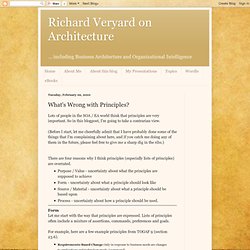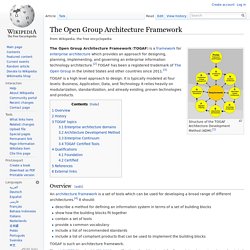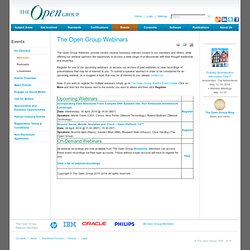

EupPoster.jpg (Image JPEG, 2089x3227 pixels) - Redimensionnée (26%) Downloads. Talking Architects with Richard Veryard. What's Wrong with Principles? Lots of people in the SOA / EA world think that principles are very important.

So in this blogpost, I'm going to take a contrarian view. (Before I start, let me cheerfully admit that I have probably done some of the things that I'm complaining about here, and if you catch me doing any of them in the future, please feel free to give me a sharp dig in the ribs.) There are four reasons why I think principles (especially lists of principles) are overrated. Purpose / Value - uncertainty about what the principles are supposed to achieveForm - uncertainty about what a principle should look likeSource / Material - uncertainty about what a principle should be based uponProcess - uncertainty about how a principle should be used. Form Let me start with the way that principles are expressed. For example, here are a few example principles from TOGAF 9 (section 23.6). Requirements-Based Change Only in response to business needs are changes to applications and technology made.
Source / Material Process. Viewpoint: 'enterprise architecture principles hugely overrated' Richard Veryard once again takes on the conventional wisdom, arguing that enterprise architecture statements of principles are hugely overrated.

They "are usually ill-conceived and generally fail to provide a sound basis for collective decision-making and governance. " EA principles 'fail to provide a sound basis for collective decision-making and governance' And this is a problem because...? Too many enterprises attempt to based their architectural; decisions on principles that are based on casual suggestions and slogans, Richard says.
Rather, they should be based on concrete, empirical evidence "that they actually work. " Too many EA statements are based on "vague wishful thinking and motherhood statements," he adds. Example: A principle may be "achieving long term loyalty" in customer relationships. The bottom line, he says, don't go overboard trying to adhere EA efforts to principles. Hmm. The Open Group Architecture Framework. Structure of the TOGAF Architecture Development Method (ADM).[1] The Open Group Architecture Framework (TOGAF) is a framework for enterprise architecture which provides an approach for designing, planning, implementing, and governing an enterprise information technology architecture.[2] TOGAF has been a registered trademark of The Open Group in the United States and other countries since 2011.[3] TOGAF is a high level approach to design.

It is typically modeled at four levels: Business, Application, Data, and Technology. It relies heavily on modularization, standardization, and already existing, proven technologies and products. Overview[edit] TOGAF or not TOGAF: Extending Enterprise Architecture beyond RUP. Develop and deploy your nextapp on the IBM Bluemixcloud platform.

Start your free trial When provided with a problem statement or pointed to a specific user need, a project team equipped with the IBM Rational Unified Process® (RUP®) approaches a solution by creating a Business Case, a Vision statement, and a Software Requirements Specification among other artifacts. These work products and the activities that produce them are well understood within both the technical and business communities. However, the ways in which we conceptualize, prioritize, and select which business problems and user needs to implement in software remains a highly variable process throughout our industry. This article explores the maturing and increasingly important role of enterprise architecture (EA) frameworks for today's software development organizations.
Contrasting different architectural frameworks. The Open Group Webinars. The Open Group Webinars provide vendor-neutral, business-relevant content to our members and others, while offering our webinar partners the opportunity to access a wide range of professionals with their thought leadership and expertise.

Register for one of our upcoming webinars; or access our archive of past webinars to view recordings of presentations that may be of interest to you. To submit a speaker abstract in order to be considered for an upcoming webinar, or to suggest a topic that may be of interest to you, please contact us. Note: If you wish to register for multiple webinars simply go to The Open Group WebEx Event Center Click on More and then tick the boxes next to the events you wish to attend and then click Register. Architecture Principles. Introduction | Characteristics of Architecture Principles | Components of Architecture Principles | Developing Architecture Principles | Applying Architecture Principles | Example Set of Architecture Principles This chapter provides principles for the use and deployment of IT resources across the enterprise.

This chapter builds on work done by the US Air Force in establishing its Headquarters Air Force Principles for Information Management (June 29, 1998), with the addition of other input materials. Introduction Principles are general rules and guidelines, intended to be enduring and seldom amended, that inform and support the way in which an organization sets about fulfilling its mission. In their turn, principles may be just one element in a structured set of ideas that collectively define and guide the organization, from values through to actions and results.
Depending on the organization, principles may be established at any or all of three levels: 204892.